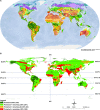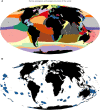A Global Deal For Nature: Guiding principles, milestones, and targets
- PMID: 31016243
- PMCID: PMC6474764
- DOI: 10.1126/sciadv.aaw2869
A Global Deal For Nature: Guiding principles, milestones, and targets
Abstract
The Global Deal for Nature (GDN) is a time-bound, science-driven plan to save the diversity and abundance of life on Earth. Pairing the GDN and the Paris Climate Agreement would avoid catastrophic climate change, conserve species, and secure essential ecosystem services. New findings give urgency to this union: Less than half of the terrestrial realm is intact, yet conserving all native ecosystems-coupled with energy transition measures-will be required to remain below a 1.5°C rise in average global temperature. The GDN targets 30% of Earth to be formally protected and an additional 20% designated as climate stabilization areas, by 2030, to stay below 1.5°C. We highlight the 67% of terrestrial ecoregions that can meet 30% protection, thereby reducing extinction threats and carbon emissions from natural reservoirs. Freshwater and marine targets included here extend the GDN to all realms and provide a pathway to ensuring a more livable biosphere.
Figures



References
-
- Rockström J., Steffen W., Noone K., Persson Å., Chapin F. S. III, Lambin E. F., Lenton T. M., Scheffer M., Folke C., Schellnhuber H. J., Nykvist B., de Wit C. A., Hughes T., van der Leeuw S., Rodhe H., Sörlin S., Snyder P. K., Costanza R., Svedin U., Falkenmark M., Karlberg L., Corell R. W., Fabry V. J., Hansen J., Walker B., Liverman D., Richardson K., Crutzen P., Foley J. A., A safe operating space for humanity. Nature 461, 472–475 (2009). - PubMed
-
- S. Teske, Achieving the Paris Climate Agreement (Springer, 2019).
-
- Tallis H. M., Hawthorne P. L., Polasky S., Reid J., Beck M. W., Brauman K., Bielicki J. M., Binder S., Burgess M. G., Cassidy E., Clark A., Fargione J., Game E. T., Gerber J., Isbell F., Kiesecker J., McDonald R., Metian M., Molnar J. L., Mueller J. L., O’Connell C., Ovando D., Troell M., Boucher T. M., McPeek B., An attainable global vision for conservation and human well-being. Front. Ecol. Environ. 16, 563–570 (2018).
-
- Griscom B. W., Adams J., Ellis P. W., Houghton R. A., Lomax G., Miteva D. A., Schlesinger W. H., Shoch D., Siikamäki J. V., Smith P., Woodbury P., Zganjar C., Blackman A., Campari J., Conant R. T., Delgado C., Elias P., Gopalakrishna T., Hamsik M. R., Herrero M., Kiesecker J., Landis E., Laestadius L., Leavitt S. M., Minnemeyer S., Polasky S., Potapov P., Putz F. E., Sanderman J., Silvius M., Wollenberg E., Fargione J., Natural climate solutions. Proc. Natl. Acad. Sci. U.S.A. 114, 11645–11650 (2017). - PMC - PubMed
-
- Martin T. G., Watson J. E. M., Intact ecosystems provide best defence against climate change. Nat. Clim. Chang. 6, 122–124 (2016).
Publication types
MeSH terms
LinkOut - more resources
Full Text Sources

